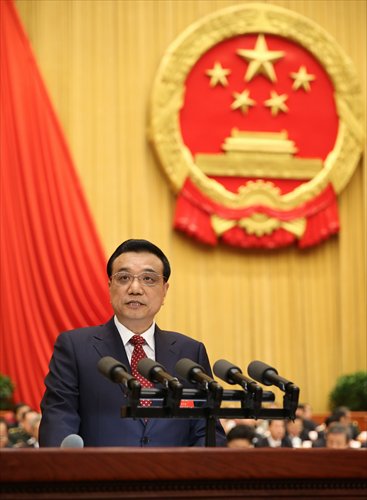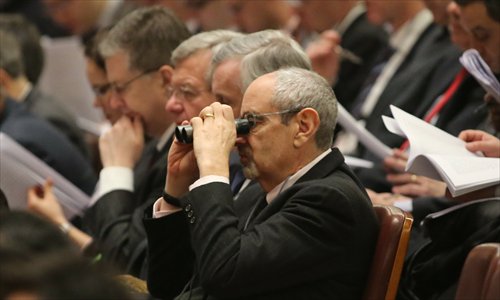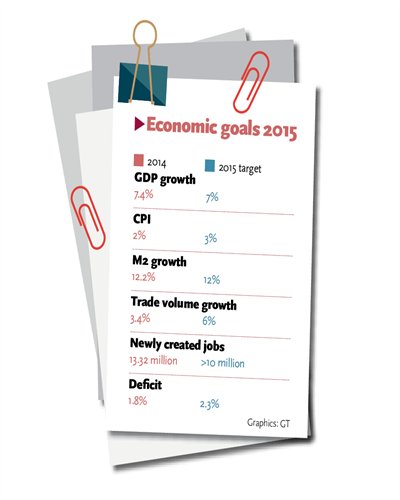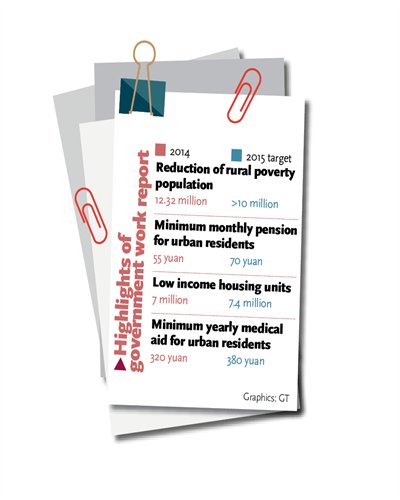Lowered 7% GDP target aims at quality growth
Proactive, prudent policies to continue: Premier Li

Chinese Premier Li Keqiang delivers the government work report during the opening meeting of the Third Session of China's 12th National People's Congress at the Great Hall of the People in Beijing on Thursday. Photo: Xinhua

With binoculars, a foreign diplomat watches Chinese Premier Li Keqiang delivering the government work report on Thursday at the Great Hall of the People in Beijing. Photo: IC


The closely watched 2015 economic growth target was unveiled on Thursday at around 7 percent, the lowest in 11 years, as the world's second-largest economy moves to retain its growth momentum while fostering high quality growth.
In his government work report delivered at the opening of the National People's Congress on Thursday, Chinese Premier Li Keqiang said the annual GDP growth target of around 7 percent "keeps pace with an increase in the size of the economy and demands of economic restructuring and upgrade."
The growth target was lowered from around 7.5 percent in 2014, which was slightly higher than the actual growth of 7.4 percent last year, the slowest growth in 24 years.
2012 was the last time the annual GDP target was revised downward, when the government lowered it to 7.5 percent from an 8 percent target that remained unchanged since 2005.
The lowered growth target reflects downward pressure on the economy which has yet to bottom out, Jia Kang, former head of the Research Institute for Fiscal Science under the Ministry of Finance and a political advisor, told reporters on Thursday.
Playing down the excessive attention to the growth target, Li Yining, a renowned economist and a political advisor, told reporters on the sidelines of another panel discussion on Thursday that the figure itself reflects expectations for the economy, the actual expansion of which is hard to predict at the moment.
Stating that the 7 percent growth target has met market expectations, Zhu Haibin, chief China economist at JPMorgan Chase & Company in Hong Kong, said in a note e-mailed to the Global Times on Thursday that "it is a bit tricky what 'around' means," as the government is less tolerant of missing the 7 percent growth target.
In his remarks, the premier said economic stabilization serves to assure the job market, adding that a growth of around 7 percent in the context of the rising share of services, as a percentage of the total economy and a growing number of small- and micro-sized enterprises, is capable of achieving relatively sufficient employment.
The country will continue to implement a proactive fiscal policy and a prudent monetary policy, the premier stated, announcing a larger budget deficit of 2.3 percent of GDP this year compared to 2.1 percent of GDP for 2014.
But strong stimulus measures will not be introduced to prop up the economy, Xu Shaoshi, head of the National Development and Reform Commission, the country's top economic planner, told a news conference on Thursday, a few hours after the government work report was given.
Among the highlights in the work report that touch on the importance of nurturing new growth sources are measures to encourage consumption, innovations and deepening structural reforms.
The premier urged in the report greater financial reforms to serve the real economy, mentioning the launch of a stock linkup between the Shenzhen and Hong Kong exchanges at the proper time.
The other economic targets for 2015 that were unveiled on Thursday include a lower annual inflation rate of 3 percent from 3.5 percent in 2014, and an increase of 6 percent in trade that was revised down from the previous year's 7.5 percent.
The trade growth target is reportedly facing greater pressure to be achieved.
"It is not easy to reach the 6 percent target, especially at a time when labor and environmental protection costs of Chinese firms continue to rise," Xu Hongcai, the director of the Department of Information under the China Center for International Economic Exchanges, told the Global Times on Thursday.
Newspaper headline: Lower GDP target aims at better growth